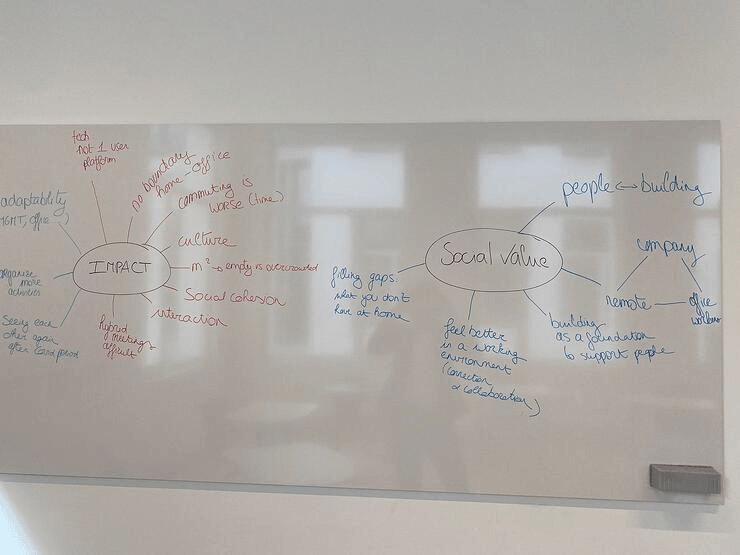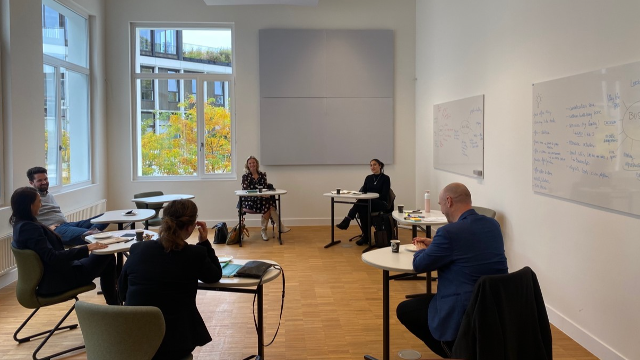What happens when you bring a real estate developer, public official, academic, technology professional and well-being expert together to discuss social value in real estate? It may be surprising to know they are on the same page: creating a workspace where needs are fulfilled that cannot be fulfilled at home. But what does this mean? What impact did COVID-19 have on organizations and – more importantly – what can we do about it?
What on earth is social value in real estate?
Everyone who participated in the discussion was clear about one thing: social value is about people. From a well-being perspective, it’s all about feeling better in a work environment. Air quality, light, furniture, noise and so on have an impact on how people are feeling. A technology professional defines it as seeing the building as a foundation to support people. The building supports social activity that wouldn’t happen if you just place those people in a boring building.
The real estate perspective – in a work context – focuses on connecting remote workers to the office in the same way office workers are. An academic view on the topic was given as well: the impact people have on their built environment and the other way around. The last definition was something everyone could relate to.
“Social value in the context of real estate, more specifically the office, is about filling in the gaps. You miss certain things at home and that’s the reason you come to the office.”
Xavier Suykens, Government of Flanders
RIP Office?
On the question if going back to the office should be regulated, the participants shared the same view. Companies shouldn’t focus on obligating people to be there a fixed number of days every week, instead they should make the trip to the office worthwhile. The office needs to facilitate life: while you’re working, other things – like laundry or shopping – are taken care of. One of the participants pointed out that social cohesion is one of biggest challenges of the post-Covid period. Another challenge is using all the available office space: one day the office is empty, the other it’s overcrowded.
“There is a big challenge in maintaining a culture. There are a lot of people you never see at the office. You’re not going to call someone to ask a silly question.”
Maarten Vyncke, Spacewell
On a more positive note, participants saw adaptability in the office grow. More bonding activities were organized and seeing each other again after the strict lockdown period felt special. However, all participants agreed that remote working negatively affected interaction and social cohesion among co-workers. Moreover, employees feel there is no boundary between home and the office. And when coming to work, the commute already feels much worse than it did before. There is work to be done!

Left: Positive (green) and negative (red) impact of Covid on the work environment
Right: What does social value in real estate mean to you?
What can we do? From team days to clubhouses
The main priority is providing the right infrastructure and technology to accommodate hybrid meetings in the best way possible. But creating a nice office environment for employees is also important: make sure you have an office in zones. Finding a concentration zone should be possible for everyone who needs it. Flexible office furniture is nice to have, maybe add a few standing and bike desks even.
Also, finding a mobility solution is important to the participants: an office close to home could be a good option for a lot of people not wanting to face horrible traffic on their commute. Xavier Suykens says the office of the future should no longer be seen as one building, but as a line-up of different spaces connected by technology. This means we don’t necessarily need everyone in the same building at the same time.
“I proposed the team to choose a day in the week we can all be together, because we only see reactions on screens and it’s not the same as real life interaction. We structured that office day as well, with sprint meetings, a lunch and a coffee break. There’s a community feeling in our team.”
Siviglia Berto, B-Tonic
“You need to look at the office like the clubhouse of your tennis club back home. You like to go to the tennis club, you see people there, you do what you came for – the tennis game (cf. work) – and after that, you grab a drink with friends. You feel connected to that club, it’s YOUR tennis club. Same holds for the office, you should feel connected to YOUR office.”
Isabelle Vandeur, CBRE
Nagwa Khady, PhD researcher at the University of Amsterdam, summarizes the discussion as follows: “‘How do we seduce people back into the office’?, that is the question today. I think it’s by giving them the choice and asking them: what do you imagine an ideal office space to look like? Building on filling in the gaps: what is it that you get at home, but don’t get at the office and how can we as an organization accommodate that?”
Is there a business case for investing in social value?
This all sounds good, but is social value in the office just a nice to have? All participants disagreed: there is an urgent business case. The problem is that the impact of social value investments are difficult to quantify, and should be seen over the long term. There are some ‘hard numbers’ to consider though. Siviglia Berto and Isabelle Vandeur suggest employee turnover and absenteeism. A recent AMS survey showed that one out of four employees did not feel connected to the company anymore during covid. The war on talent is real, and adding social value to office spaces can help to win it.
“It is best to invest a little bit every year. It will cost much more to wait five years and have to completely renovate an outdated, and possibly empty, office.”
Maarten Vyncke, Spacewell
So, how much to invest per employee? This is a question Siviglia Berto is asked often. And there is no easy answer. She tells clients that if you have the best well-being policy, but crappy leaders, you will change nothing. On the other hand, a cheap office space with a great boss or manager can make a big difference. Leadership is very important. Social value is not one ingredient; you need to have all of them. Xavier Suykens adds that leadership will have an impact on the return on investment too. If you invest in changes, you need to make sure that leaders stand behind them. That way these investments will have the most pay-off.
Definitely some things to think about when aligning a new work policy or deciding about the lay-out of your future office(s).
Discover the chair on Social Value in Real Estate - LAMMP
About the authors
Shirley Kempeneer: Holder of the LAMMP Chair for Behavioral Insights in Real Estate at Antwerp Management School and assistant professor at Tilburg University
Sarah Desmet: Social Value Expert at LAMMP & Researcher at Antwerp Management School

comments0
You don't have the rights to read or add a comment.
Suggested Articles


